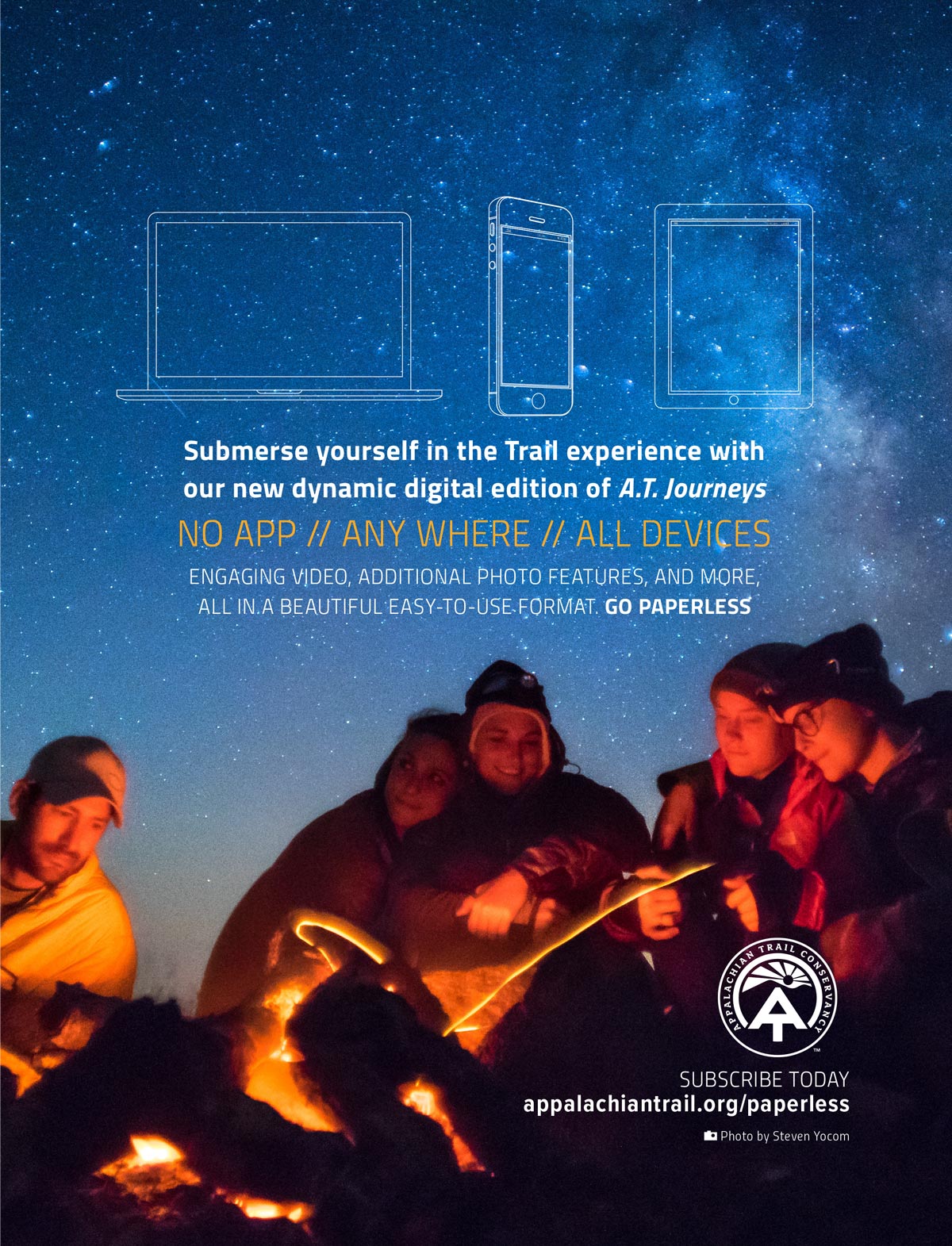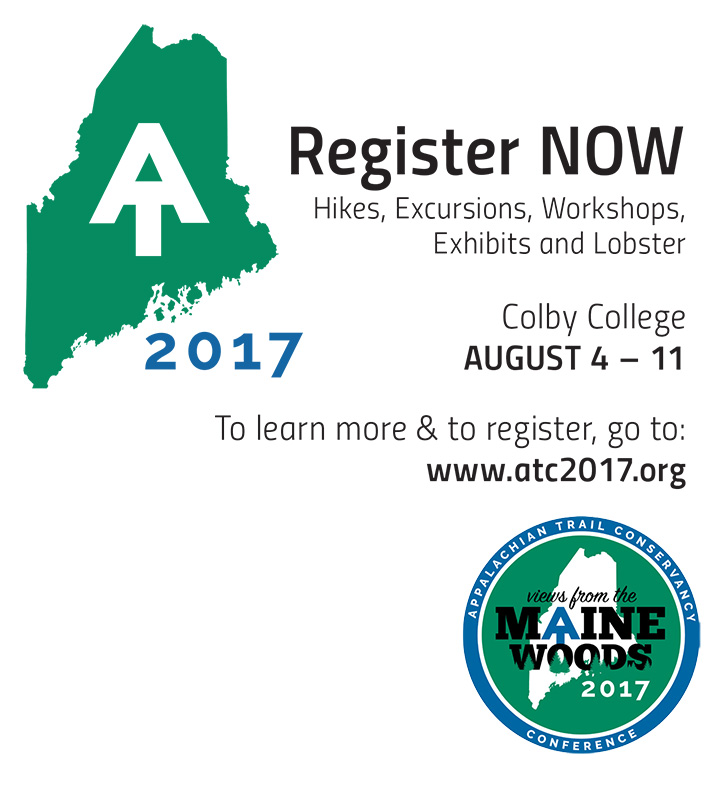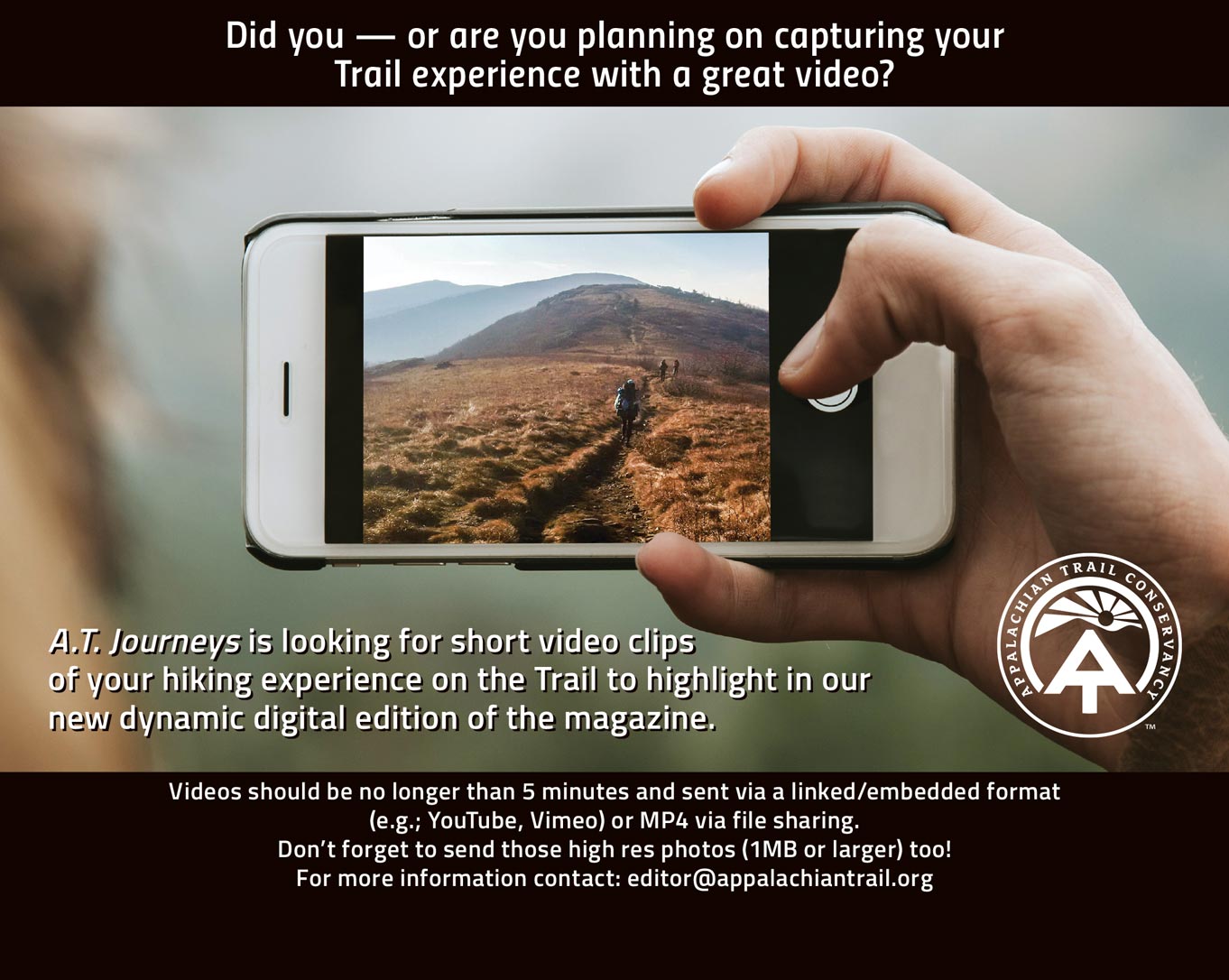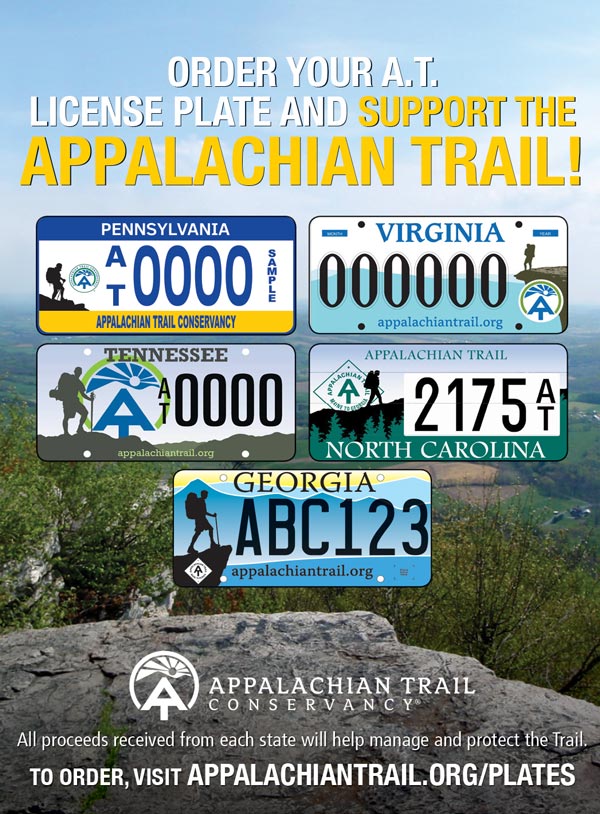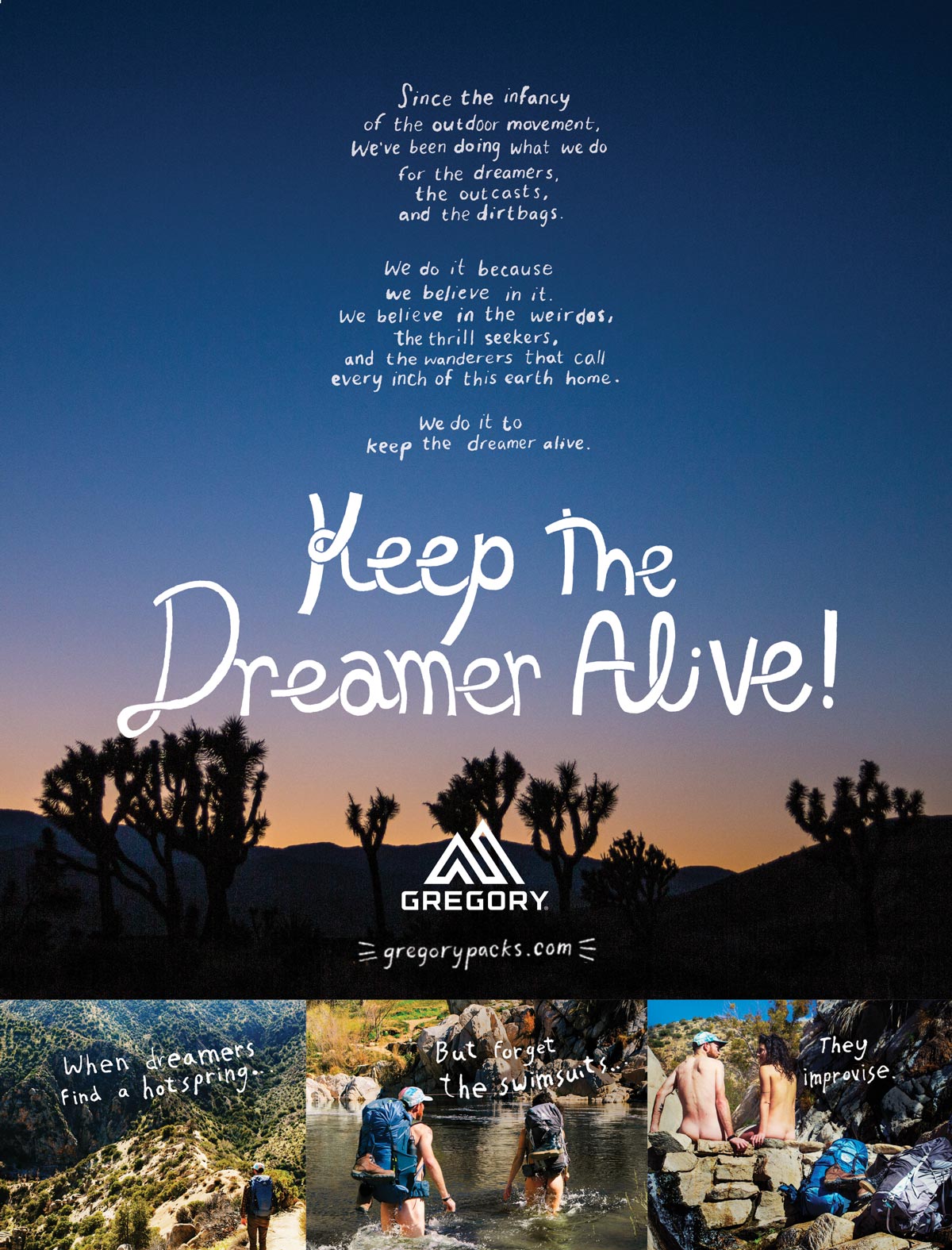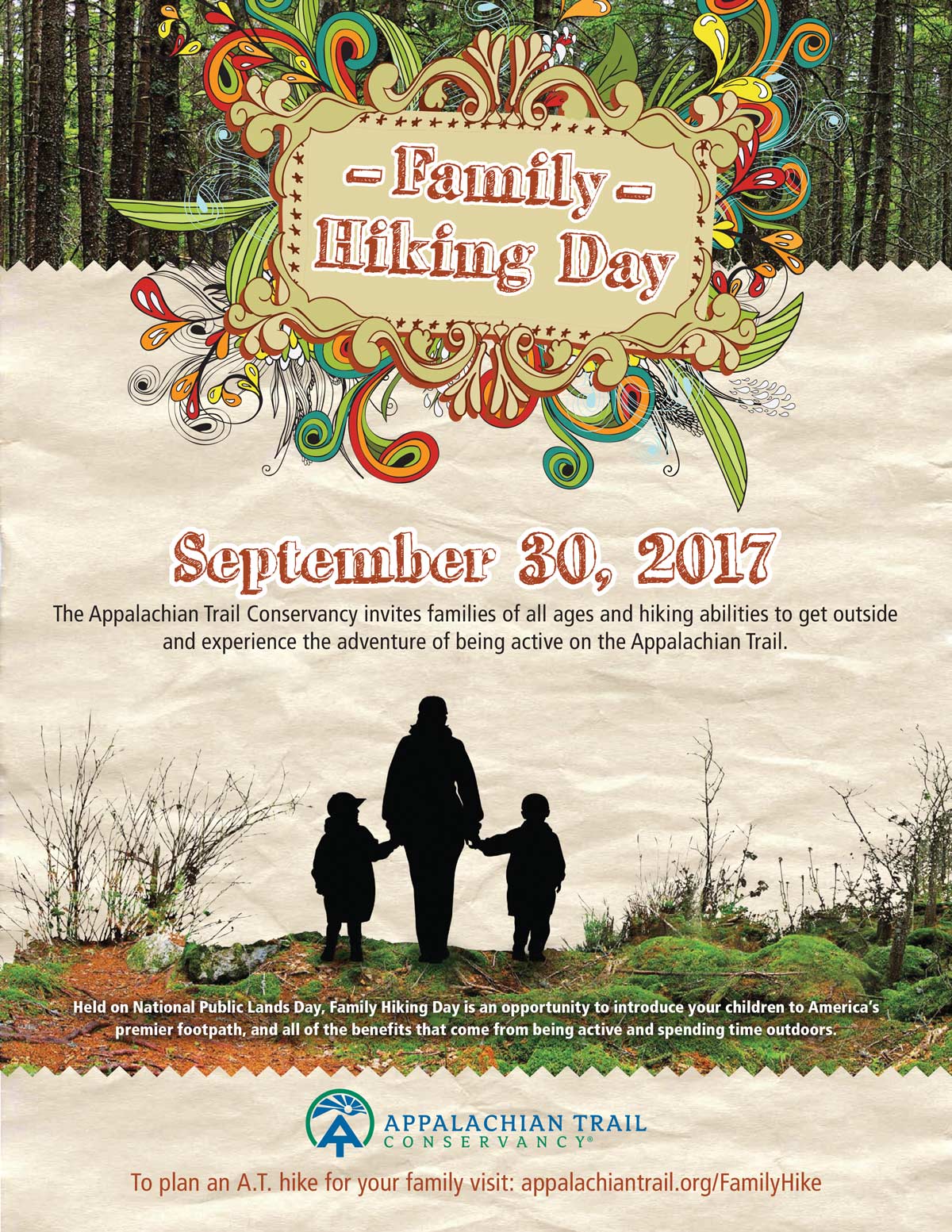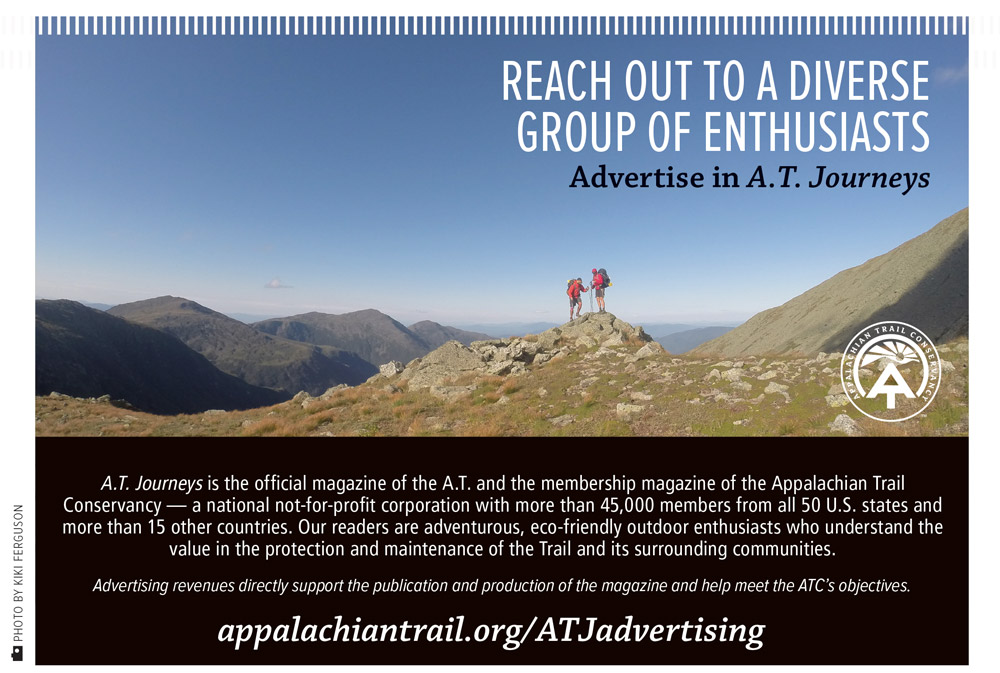Support the Trail You Love

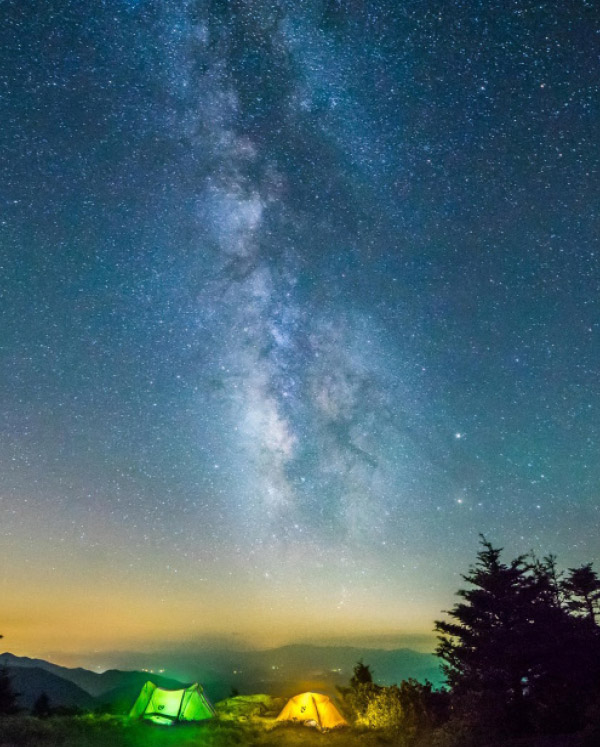
Milky Way over A.T. – Pisgah National Forest
Ronald J. Tipton / President & CEO
Stacey J. Marshall / Vice President of Finance & Administration
Tiffany Lawrence / Vice President of Membership & Development
Laura Belleville / Vice President of Conservation & Trail Programs
Brian B. King / Publisher
Javier Folgar / Director of Marketing & Communications
Wendy K. Probst / Managing Editor
Traci Anfuso-Young / Graphic Designer
Laurie Potteiger / Information Services Manager
Brittany Jennings / Proofreader
Sandra Marra / Chair
Greg Winchester / Vice Chair
Elizabeth (Betsy) Pierce Thompson / Secretary
Arthur Foley / Treasurer
Beth Critton
Norman P. Findley
Edward R. Guyot
Mary Higley
Daniel A. Howe
Robert Hutchinson
John G. Noll
Colleen T. Peterson
Jennifer Pharr Davis
Rubén Rosales
Nathaniel Stoddard
Hon. C. Stewart Verdery, Jr. / Chair
Shooter Starr / Vice Chair
Donald Ayer
Colin Beasley
Sonja Carlborg
Kathi Cramer
Constance I. DuHamel
Wendall T. Fisher
Lisa Koteen Gerchick
Destry Jarvis
Jessica Herrera-Flanigan
R. Michael Leonard
Robert Rich
For membership questions or to become a member, call: (304) 885-0460
![]()
[email protected]
A.T. Journeys is published four times per year. Advertising revenues directly support the publication and production of the magazine, and help meet Appalachian Trail Conservancy objectives. For more information and advertising rates, visit: appalachiantrail.org/atjadvertising
Observations, conclusions, opinions, and product endorsements expressed in A.T. Journeys are those of the authors and do not necessarily reflect those of members of the board or staff of the Appalachian Trail Conservancy.
A.T. Journeys is published on Somerset matte paper manufactured by Sappi North America mills and distributors that follow responsible forestry practices. It is printed with Soy Seal certified ink in the U.S.A. by Sheridan NH in Hanover, New Hampshire.
A.T. Journeys ( ISSN 1556-2751) is published quarterly for $15 a year by the Appalachian Trail Conservancy, 799 Washington Street, Harpers Ferry, WV 25425, (304) 535-6331. Bulk-rate postage paid at Harpers Ferry, West Virginia, and other offices. Postmaster: Send change-of-address Form 3575 to A.T. Journeys, P.O. Box 807, Harpers Ferry, WV 25425.

(ATC) is very committed to protecting the natural and cultural features along the A.T. and especially the scenic values that attract an estimated three-million hikers annually. The ATC has a long history of challenging a number of proposed developments along the Trail, including residential subdivisions, auto racetracks, casino resorts, wind turbines, and communication towers.
The last issue of A.T. Journeys included a feature article about the proposed Mountain Valley natural gas pipeline (“Cutting to the Core”) that would extend 300 miles from West Virginia in order to transport natural gas extracted from the Marcellus Shale across the Appalachian Mountains to connect with the Transco Pipeline in eastern Virginia. The MVP project (as it is commonly called) is one of four proposed gas pipelines now awaiting approval by the Federal Energy Regulatory Commission (FERC) that would cross the A.T. in Virginia or Pennsylvania.
The ATC has closely examined all four of these routes and has concerns about the potential impact on the Trail experience from each proposal. Yet we have only come out in opposition to the MVP route.
I want to explain the process that led to the decision to oppose the MVP. When we first heard such a pipeline was in the planning stages, we reached out to the consortium of energy companies supporting Mountain Valley to obtain the information we needed to evaluate its likely impact on the Trail. At the same time, we began a series of discussions about the project with the U.S. Forest Service and the National Park Service, both of which have key roles in the approval process. The result was that the Mountain Valley proponents essentially ignored our concerns, while both the Forest Service and the Park Service raised many of the same issues we did.
To be frank, we are very disappointed that the MVP consortium would not engage in discussions or provide the data that could lead to a better route with much less impact on the A.T. We paid for an independent visual impact analysis of how a pipeline corridor up to 500 feet wide would affect the Trail experience from Pearisburg north to the Roanoke area. It is clear from this analysis that the scenic values from vistas such as Angel’s Rest, Kelly’s Knob, McAfee Knob, and numerous others would be degraded.
Based on this information and the unwillingness of the MVP consortium to have a productive dialogue with us, we are strongly advocating the proposed MVP route be rejected by FERC. We took this position consistent with a policy position for considering petroleum pipeline development approved by the ATC’s Stewardship Council and Board of Directors. That policy statement says: “The ATC seeks to avoid, minimize, or eliminate the visual and experiential impacts of all utilities — including oil, gas, and petroleum-product pipelines, on the Trail and its surrounding landscapes.”
It is my view that the ATC should be very careful and selective in deciding that a specific development proposal is unacceptable. We have a long track record of working with government agencies, local communities, and the private sector to assure the Appalachian Trail experience is protected for the enjoyment of future generations. This requires us to be a strong voice for conserving the A.T. landscape and the many great vistas along the Trail consistent with environmentally acceptable development that benefits our country.
For more information about the proposed MVP project visit: appalachiantrail.org/MVP
Volunteers from the Maine A.T. Club repair a cairn at the summit of Katahdin in 1939
![]() Photo by Mark Taylor
Photo by Mark Taylor
Letters
received proof that the effort to encourage “flip-flopping” by prospective A.T. thru-hikers is gaining acceptance, even out here. Case in point: In Oregon, I have run into several hikers who have backpacked all or part of the Pacific Crest Trail (PCT) and now wish to take on the A.T. I recently met a young male employee at Trader Joes here in Corvallis who noticed my A.T. logo hat, which served to initiate a conversation on a favorite shared subject. He expressed his intention to hike the A.T. next year after completing a preparation hike of the Oregon portion of the PCT this summer. In asking him where he planned to begin his A.T. hike, he immediately invoked Harpers Ferry. “Great idea!,” I intoned, followed by, “Do you realize such a plan is called flip-flopping?” He said he had and that the idea was appealing to him. We can hope that more potential thru-hikers, no matter where their home base, will similarly embrace a flip-flop hiking plan.
Karl Hartzell
note with food and drink for fellow hikers: Thank you for your efforts to welcome thru-hikers to Massachusetts this spring. I’m sure they valued your support, and appreciated the food and drink you left by Rt 41. Unfortunately, the maintainer caring for this section of the Trail encountered the empty bottles and remnants of food that were left behind with his brush cutter and spend an unpleasant 15 minutes gathering up the scattered smelly and decaying bits and pieces, then putting them into his truck and carrying them home for disposal. While I’m sure a few hikers appreciated your gesture (although there is ample water in this section, and access to resupply is relatively easy), the “magic” of your effort was definitely lost on the maintainer, who refers to it — perhaps more accurately — as litter.
Cosmo Catalano
bottom, an economic one. And this alone is bad enough, even in a period of so-called ‘normalcy.’ But living has been considerably complicated of late in various ways — by war, by questions of personal liberty, and by ‘menaces’ of one kind or another.”
Benton MacKaye wrote this in 1921 — when the world seemed extremely complicated and uncertain. I don’t think I’m alone in feeling we are now again struggling with much of the same fears and uncertainties. We seem to be at a pivotal point for our country and our planet. So, what can we do within the tiny space in which we have some control and certainty?
For MacKaye it was simple: “There are three things: To walk, to see, and to see what you see.” Living as we do now, in Harpers Ferry, my husband, Chris and I need only to walk out our back door to see what we see.
Beyond the hikers, there is the community. My morning constitutional will take me past Harpers Ferry National Historical Park and the Appalachian National Scenic Trail park offices, where dedicated and talented public servants are busy meeting and greeting visitors from around the world. The ATC Visitor Center volunteers work seven days a week to share the story of the Appalachian Trail to one and all passing through their door.
With just a few more steps you can follow the white blazes through town and back onto the Trail. Heading north, you walk along the C&O Canal to where the A.T. veers left up Weverton cliffs and beyond to Katahdin. The southern trek takes you across the Shenandoah River and a climb up Loudoun Heights from where Springer Mountain lies just a little over 1,000 miles.
It is a beautiful town and a gateway to the even more spectacular refuge that is the Appalachian Trail. Yet, in all honesty, and with all this literally out my back door, I too often find myself engrossed in news reports and on-line chatter. I succeed only in raising my blood pressure and reducing my spirit. In reading MacKaye, I realize that this, unfortunately, is the default human condition. He wrote: “For we need this thing wilderness far more than it needs us. Civilizations (like glaciers) come and go, but the mountain and its forest continue the course of creation’s destiny. And in this we mere humans can take part-by fitting our civilization to the mountain.” Ninety-six years later, this still rings true. I’m lucky to live in a town that has fit its civilization into the mountain. I just need to walk out my back door more often. Here’s hoping you too can take that walk, to see, and to see what you see.

By Jessica Porter
Trail magic is a term that is often misconstrued. By the Appalachian Trail Conservancy’s (ATC) definition, Trail magic is a serendipitous experience on the Appalachian Trail. Mostly, it’s unplanned acts of kindness by strangers, though a liberal interpretation might include a mesmerizing sunset after days of soaking rain, or a wildlife sighting so thrilling it makes your heart pound.
I experienced this concept first hand during my 2014 thru-hike. In Hanover, New Hampshire, a nearby couple overheard my partner and me struggling to find a place to rest our aches and pains. They invited us to their home, where they fed and entertained us for two days. It was the first time they had helped hikers, and that random act of kindness will always shine through as a top memory of our journey.
In the last few years, the term Trail magic has expanded in the hiker community to encompass many other forms of kindness on the Trail, including hiker feeds, leaving a cooler full of treats by the Trail, setting up tables of food and snacks, and cooking ornate meals at shelters. No one disputes these efforts go above-and-beyond in the kindness department, but they are technically not considered Trail magic, and may do more harm than good.
“By definition, any pre-planned event wouldn’t be Trail magic because it’s contrived. It doesn’t make something planned any less of a kind gesture, but it’s not Trail magic,” says the ATC’s Trail information specialist Tenny Webster. “It’s not value laden, this definition; it just honors the random, dumb chance — the serendipity — of an experience for everyone involved. This may sound restrictive to some folks, but shouldn’t something magical require a high bar, anyway?”

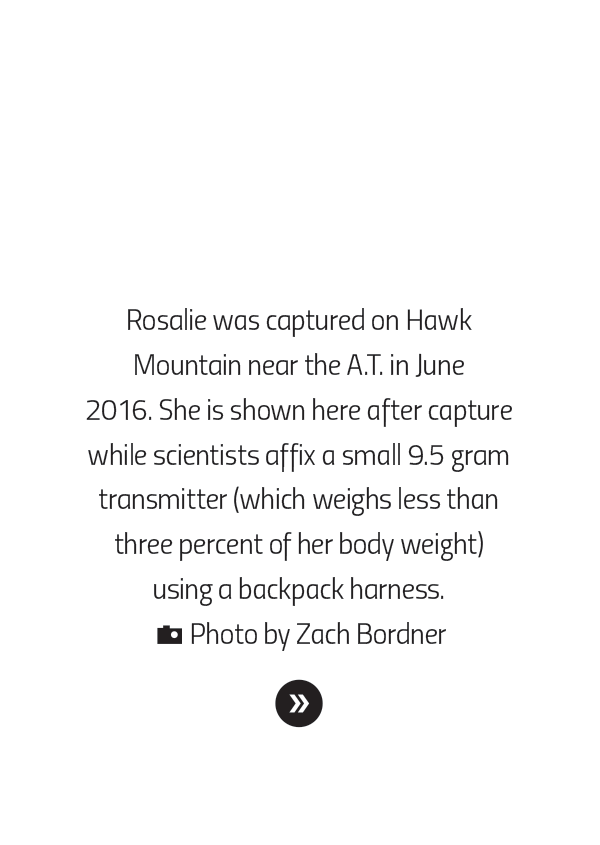
Rosalie the Hawk Finds her Way back to the A.T.
On February 1, Rosalie, an adult female broad-winged hawk tagged in summer 2016 at Hawk Mountain and sponsored by the Kittatinny Coalition, moved slightly north of her southern Peru wintering site and lingered for 10 days. By mid-February, she started moving in earnest, heading north toward Colombia. She then flew south in the fall and, in late March, she arrived in Panama and continued on to Mexico. Soon after, she flew past the Veracruz River of Raptors site along the Gulf of Mexico and continued into Texas in early April. Following the Appalachians foothills north, she crossed Virginia on April 22, passing just west of Washington, D.C. and arrived just southwest of Hawk Mountain in Gamelands 106 on April 25th where she spent the evening. Her final hop over the mountain into her territory in the lower River of Rocks occurred on April 26th when her transmitter signaled from near the Appalachian Trail corridor — “home sweet home” — after 85 days of travel from southern Peru to Hawk Mountain Sanctuary on the Kittatinny Ridge in eastern Pennsylvania. The Hawk Mountain Sanctuary field team is ready to find out if she will reunite with her mate from last year and build a new nest. Rosalie was named for Rosalie Edge, the founder of Hawk Mountain and a passionate conservationist. Edge founded Hawk Mountain Sanctuary in 1934 to stop the shooting of birds of prey and worked tirelessly to achieve legal protection for raptors throughout the 1940s and 1950s. Hawk Mountain has grown into a world-renown raptor conservation organization with full-time programs in conservation science and education. Hawk Mountain manages a 2,500-acre sanctuary adjacent to the Appalachian Trail in Kempton, Pennsylvania, with eight miles of trails open to visitors daily. It works closely with the Appalachian Trail Conservancy and others to conserve the Kittatinny Ridge corridor for migrating raptors.
To learn more about Hawk Mountain Sanctuary visit: hawkmountain.org
To track Rosalie’s current location — available in August after nesting season ends — and track other raptors’ journeys visit: hawkmountain.org/birdtracker
Passing the Torch
ATC’s President Plans for Retirement

Ron stops at the ATC Visitor Center in ’06 during a hike
Sandra Marra, chair of the Board of Directors, has announced that the Appalachian Trail Conservancy’s (ATC) president and CEO Ron Tipton will be retiring at the end of 2017. Ron was hired as executive director/CEO by the ATC Board of Directors in the summer of 2013; his title was changed to president by the board early this year. Under his leadership, the organization has advanced in a number of significant ways, including:
- A five-year Strategic Plan was approved by the board in 2014 and has provided a critical framework for managing and protecting the Appalachian Trail, fundraising, budget priorities, and staffing decisions
- The annual ATC operating budget has increased from $6.4 million in 2013 to $9.6 million for the current year, and the number of full-time staff has grown from 48 to 58. The ATC has experienced very significant growth in fundraising, especially through major gifts, corporate partnerships, and bequests
- The ATC has significantly expanded its role in managing the Trail to address the growing number of long-distance, weekend, and day hikers in order to protect the A.T. hiker experience
- New initiatives are moving forward to protect high-priority large landscapes along the Trail and to broaden the relevancy of the A.T. to attract young and diverse populations
“Finding a new President and CEO to lead this organization into the future is of the utmost importance to the Board of Directors,” says Marra. “Through Ron’s leadership and guidance, we have both a strong and stable foundation as well as the potential for significant growth and response to future challenges for the ATC’s Trail management and protection. We are confident that the ATC will successfully complete this next transition and will continue this strong and positive trajectory to the future.”
The ATC Board has hired an executive search firm, ThinkingAhead Executive Search, which specializes in nonprofit leadership recruitment to help identify and hire Tipton’s successor. The search process began in late May and is moving forward.

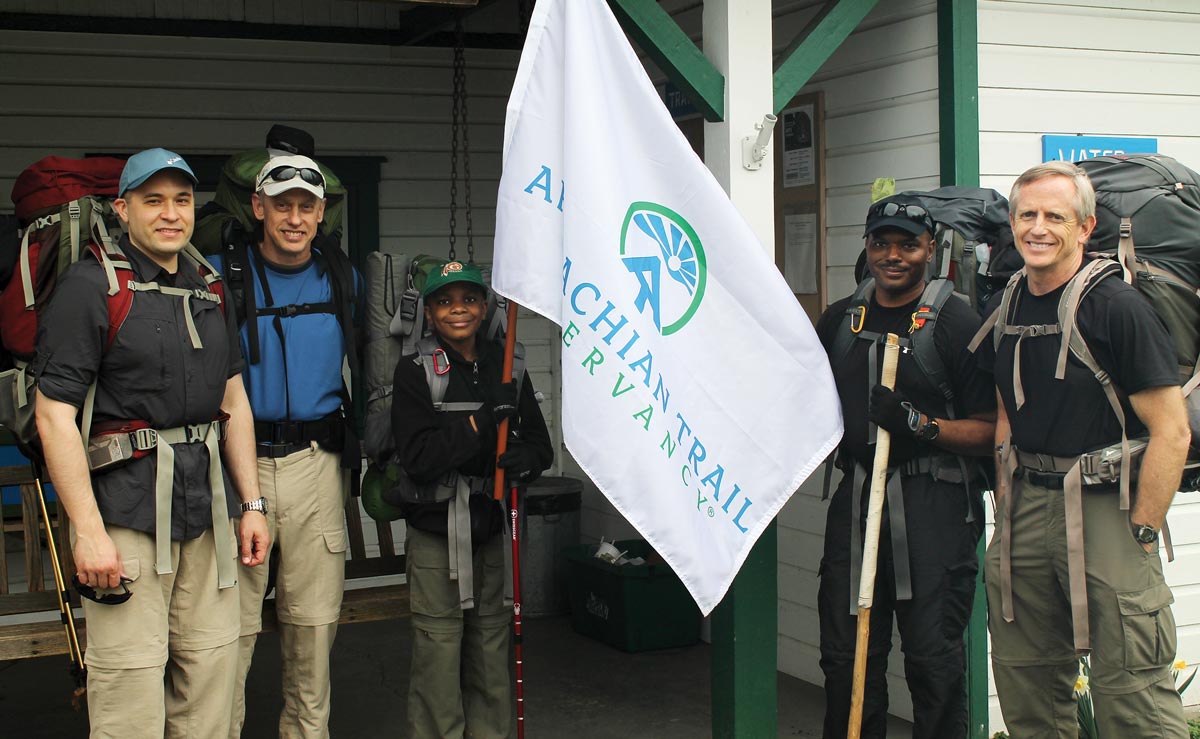
Come visit us on the Trail
The Appalachian Trail Conservancy (ATC) currently has three visitor centers along the Trail that provide a destination for hikers and visitors of all types. Our information and visitor centers are found in Harpers Ferry, West Virginia, Boiling Springs, Pennsylvania, and Monson, Maine, with a fourth center expected to open in Damascus, Virginia in 2018. Whether you are a hiker or just love the Trail, each of our centers provides a unique experience that will leave you wanting to get out hiking.
Harpers Ferry: Located in the heart of the Harpers Ferry National Historical Park, and just 0.2 miles from the A.T., the Harpers Ferry Visitor Center — also the site of ATC Headquarters — acts as a halfway milestone for long-distance hikers and is open year-round. Notable attractions here include a one- of-a-kind raised relief map of the entire A.T., photo albums of prospective 2,000-milers dating back to 1979, maps, guides, books, merchandise, and exceptional volunteers who make the visitor center experience possible.
Boiling Springs: Right on the Trail at the ATC’s Mid-Atlantic Regional Office and located next to beautiful Children’s Lake, the Boiling Springs Visitor Center is the perfect place to learn about the A.T., ATC, and the surrounding area. Also open year-round, the center hosts free events for the local community and hikers passing through. This has helped to make the Trail beloved to the locals and build an impressive A.T. Community group. The center welcomes more than 11,000 people a year and is the only information and visitor center on the Trail with conservation staff in house. This offers the hikers an immense opportunity to talk with the people who work to preserve and protect the Trail.
Proud Man/Woman Award
The Appalachian Trail Conservancy’s (ATC) Proud Man/Woman award – ATC’s highest recognition for outstanding performance by a staff member – was established in 2015 to recognize the profound and enduring contributions of Bob Proudman who served the A.T. for 50 years in a variety of roles, including 35 years of employment with the ATC. The award criteria is based on demonstrated excellence in each of the ATC’s five core values: cooperation, integrity, inclusion, dedication, and empowerment. The recipient is chosen by fellow ATC employees through a nomination and voting process.
This year, Laurie Potteiger, the ATC’s information services manager, was chosen for myriad reasons — all of which demonstrate her dedication to the ATC and the Appalachian Trail and her devotion, professionalism, compassion, introspection, and grace.

The Appalachian Trail Conservancy (ATC) is pleased to announce that it will be developing a Tribute Garden at its headquarters in historic Harpers Ferry, West Virginia.
The garden will be a permanent public memorial honoring those who have walked on, helped protect, or been inspired by the A.T. For hikers and guests alike, it will be a lovely and tranquil space to savor the morning sun or evening breeze while taking in the views of the surrounding Blue Ridge Mountains. It will also be a space where loved ones, volunteers, members, hikers and staff can be celebrated and remembered. And it will serve as a beautiful and fitting place to commemorate the generosity of donors who support the ATC’s legacy and future. Brick sales will begin in summer 2017 in preparation for the garden’s groundbreaking in fall 2017.
For more information or to order an engraved brick to be placed in the garden for yourself or a loved one visit: appalachiantrail.org/TributeGarden
If you are interested in additional engraving opportunities such as benches, picnic tables, boulders, or a fountain, please contact us at: [email protected]
Call For A.T. Videos

Did you — or are you planning on capturing your Trail experience with a great video?
A.T. Journeys is looking for short video clips of your hiking experience on the Trail to highlight in our new dynamic digital edition of the magazine. Videos must be no longer than five minutes and must be sent via a linked/embedded format (e.g.; YouTube, Vimeo) or MP4 via file sharing.
For more information and to send videos contact: [email protected]
Beauty is NOT in the Eye of the Beholder
“Beauty is in the eye of the beholder” is a phrase often tossed out by people seeking to develop the natural landscape along the A.T. corridor (by the way, this is not a quote from Shakespeare, but from a 19th Century novel). There is an intrinsic beauty in certain landscapes along the A.T. that is not enhanced by mountaintop buildings, pipeline corridors, and wind turbines — despite the claims of developers. Rather, the intrinsic beauty can be degraded and marred by certain development. This natural aesthetic beauty deserves protection.
This year, the Maine Appalachian Trail Club and the Appalachian Mountain Club introduced legislation to better balance our need for renewable energy and the visual impact of ever-larger wind turbines (the largest wind turbines in the Western Hemisphere were erected in Maine last fall) from viewpoints along the A.T. (the bill failed). Pipeline projects like Northern Pass in New Hampshire and Mountain Valley in Virginia will forever alter the natural aesthetic of mountain views enjoyed by Trail users. The value of jobs and economic return is often not measured against the loss in the value of the natural aesthetic.


Clockwise from top left: Percival Baxter; Myron Avery; Avery with measuring wheel on the Knife Edge in 1933 — on his way to set his first summit sign
![]() courtesy Maine State Library
courtesy Maine State Library

Those leaders were both graduates of Bowdoin College and Harvard Law School, basically a generation apart. Both were passionate about, if not obsessed with, the “greatest mountain” as central to their present times and most certainly to their legacies. One could pursue their story as a sort of a love triangle gone sour: jousting knights — Percival P. Baxter and Myron H. Avery — in a quest for the role of Katahdin’s steward.
Or perhaps it’s a tale of class rivalry. Baxter’s politician father made his fortune in the canning industry along Maine’s coast, the inherited portion of which his son used to buy the 200,000 acres now comprising Baxter State Park. Two hundred miles up that coast from Baxter’s Portland, Avery’s father managed sardine-canning operations for a local owner. It was the town’s economy. Myron was never interested, his own siren being the mountains 150 miles to the northwest and its heart: a mile-high, glacially scarred, granite monolith rising above the evergreens. The history of the relationships between Baxter — the man and the park — and the multilayered creation and management of the Appalachian Trail is neither that simple nor straightforward, however.

Clockwise from above right: Dr. Jeff Marion’s graduate assistants collect data on the A.T. in Virginia near Blacksburg that will give Trail managers more insights into which sections of A.T. are sustainably designed and maintained; Volunteers from the Maine Appalachian Trail Crew spent years working to stabilize the A.T. on the north slope of White Cap Mountain; Konnarock Trail Crew members assist the Roanoke A.T. Club with relocation work on Sinking Creek Mountain in Virginia
The first time I ever set foot on the Appalachian Trail, it was as a Trail maintainer. I was just about to begin my freshman year of college at Dartmouth, and was partaking in the long tradition of “First-Year Trips,” a rite of passage organized by the Dartmouth Outing Club, or the DOC. These five-day trips, just before the start of orientation, are a way for new students to meet one another and connect with the land that they will call home for the next four years. Trips run the gamut from rock climbing to nature photography, from “extreme hiking” to cabin camping. Many of them take place along the Appalachian Trail. That summer, I had chosen trail work as one of the trip options that I was interested in, and there I found myself, getting dropped off with my “trippees” along Route 25A at the base of Mount Cube. We hiked south along the A.T. to Smarts Mountain. In an effort to keep hikers from falling and twisting their ankles, we spent the next two days crushing rocks and piling them under the steps of a wooden staircase that the DOC’s summer trail crew had built just a few weeks prior.


ISA Certified Arborists and Champion Climbers (left to right) Melissa LeVangie, Tom Ingersoll, Luke Soule, Brian Carpenter, Daniel Weise, Jason Bresson, and Russell Plumb
car on the side of West Dover Road near the Appalachian Trail, just a few miles north of the town of Pawling, New York. A number of people were moving around the area with brisk and purposeful strides. As I stepped out of the car and walked toward the others, I was struck by a tangible energy in the air. It was a feeling of exhilaration and excitement that would set the tone for the remainder of the day. As additional vehicles began to arrive, I watched their passengers eagerly going to greet each other with the type of enthusiastic hug or handshake reserved for a good friend you haven’t seen in some time.
It was a white oak tree (Quercus alba) that had brought this group of people together on this particular National Arbor Day, but it wasn’t just any white oak, and the visitors certainly weren’t your typical A.T. visitors. The group was comprised of some of the very best International Society of Arboriculture Certified Arborists and Champion Climbers from the states of New York, Connecticut, and Massachusetts. They had all met here in Pawling to provide a day of service to one of the largest white oak trees in the state of New York, the Dover Oak. Standing at 85 feet in height and 81 inches in diameter, the Dover Oak is a splendor to behold. Its limbs, many of which are outstanding in their own right, stretch in all directions, first aiming skyward and then arching back down toward the ground. It is estimated that the tree is around 250 years old, but its age has long been disputed, and some suspect it is considerably older. We can only speculate as to how and why it came to be that this tree was spared when the area was heavily deforested in the mid to late 1800s.
Achieving A Vision
“There is no trail more powerful to capture images on than the A.T.,” says photographer Steven Yocom. “At any given day on the Trail, I can be inspired beyond belief by a total stranger, be humbled by their stories, and walk away with lifelong friends who share the same passions and seek the same answers as I do.” Born and raised in Philadelphia, Pennsylvania, Yocom has now lived in Western North Carolina for five years. His two dogs, Sage and Cain come just about everywhere with him – as does his girlfriend Brindley, when she can get off work.
“I am grateful to have some of the most beautiful stretches of the Trail in my back yard. I’d say Grayson Highlands and the Roan Highlands are by far my favorites,” says Yocom. “Studying maps, direction of the light at that specific time of day, what is blooming, and even what time the moon will rise and set has all become very important for me to taking things further and achieving a vision I may have. They say there’s nothing greater in life than to follow your dreams and do what you love. I have found something I am more passionate about than ever and I am actively chasing that dream.”
steveyocomphotography.com
![]() See Steven at work on the Trail at: steveyocomphotography.com/atcinterview
See Steven at work on the Trail at: steveyocomphotography.com/atcinterview
Credit: film created and produced by Jacob & Luke Sutton with Creative Campfire – specializing in lifestyle, branded and outdoor video production in western North Carolina: creativecampfire.co Instagram: @creativecampfire & Vimeo: vimeo.com/creativecampfire
Steven with his “assistant” Asia on the A.T. along the Wilburn Ridge area of Grayson Highlands
Profiles
Konnarock Trail Crew
Konnarock Crew members work with the Tennessee Eastman Hiking and Canoeing Club to relocate a very steep section of the Trail at Backbone Rock in Tennessee
Labor of LOVE
By Clay Bonnyman Evans
series of human-made stone steps to Vermont Route 9, one of the steepest half-mile sections on the Appalachian Trail, in a torrential downpour when it really struck me how much work it takes to keep the Trail healthy, sustainable, and free of obstruction. How in the world do they get these massive boulders into place? I wondered, grateful to the anonymous rock-haulers who had eased my descent.
Nine months later, strapped like a mule to a six-hundred-pound chunk of granite near the crest of Yellow Mountain on the Georgia-North Carolina border, I have my answer: inch-by-inch, via teamwork, with plenty of thick, mud-grimed yellow webbing, sheer muscle, and lots of grunts and groans. “One … two … three!” barks Justin Farrell, crew leader with the Appalachian Trail Conservancy’s (ATC) storied Konnarock Trail Crew. Five guys hoist the rock a few inches off the ground and I drive my legs hard, tugging it forward a couple of feet. A dozen such efforts and we’re ready to maneuver the boulder into position for a single French drain on this one small section of the 2,189-mile Trail. “Working on the crew really makes you realize how hard it is to keep the Trail maintained,” observes volunteer Haley Holiman, a 20-year-old wildlife sciences student at Mississippi State University.
Trail Stories
Early sunrise in Maine ![]() Photo by Devon “O.R.B” Snedeker
Photo by Devon “O.R.B” Snedeker
therapy to Navy Sailors, SEALs, and Marines returning from war, I thought I knew about grief. When my son was killed in a motorcycle accident, I knew nothing until I picked up my pack and started to walk. “If you aren’t at Katahdin, you ain’t nothing,” a hiker told me. But I found that it’s not about the destination, it’s the journey. It was the 2,198.2-mile journey from Georgia to Maine that took me to up the tops of mountains and down to deep despair. Tears of happiness during the day and tears of loss flooded my heart at night knowing that Aaron wasn’t here to walk with me.
I dealt with the void left from the death of my son the year before by filling it with hope that I found along the Trail. With the lightest gear I could afford, one pair of shorts, two shirts, and a floppy hat, I took to the Trail after an eleven-hour bus ride.
My gray beard grew as my clothes got baggier. I looked like something that climbed out from under a Grimm’s fairytale bridge. The Trail gave me the space to have a talk with the one I was most angry with — God. God’s world opened up when everything I owned was on my back and my only concern was the next white blaze.
Trail Giving
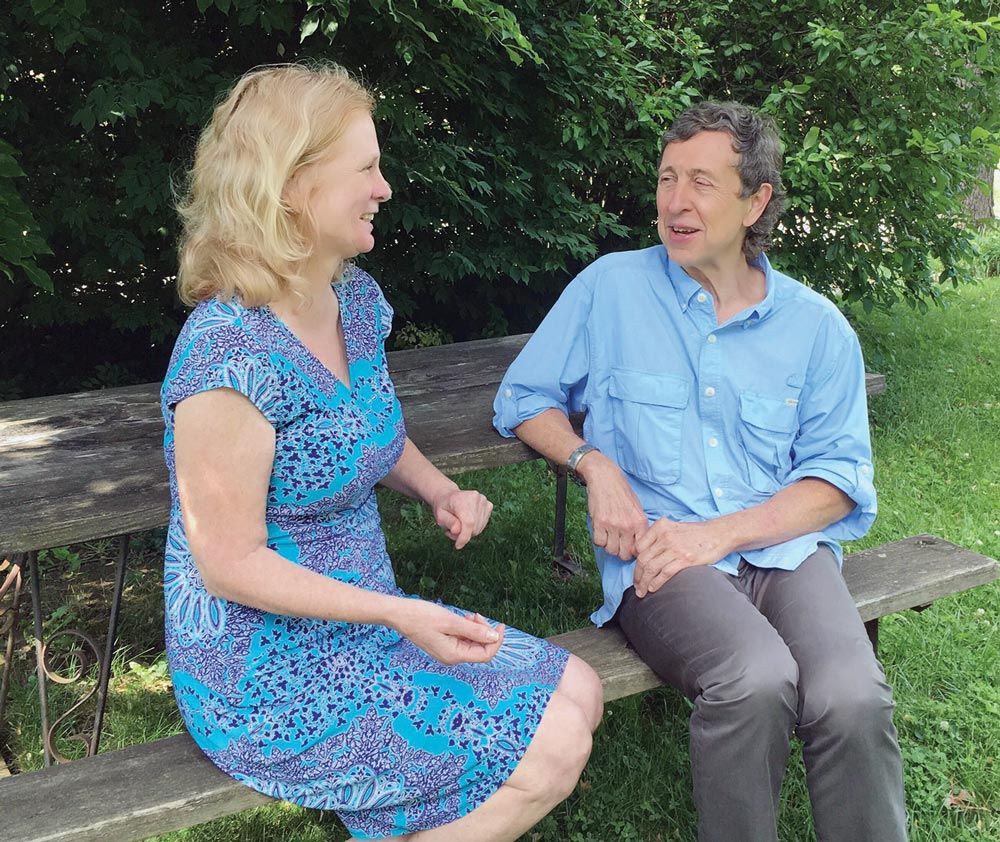
Marie Uehling and the ATC’s President & CEO Ron Tipton sit in the area that will become the ATC’s Tribute Garden
![]() PHOTO BY TIFFANY LAWRENCE
PHOTO BY TIFFANY LAWRENCE
Development is doing its own version of a NOBO (north-bound hike) — as we hosted and will host events in Atlanta, Washington, D.C., Pawling, New York and, of course, the Kathadin of all gatherings, the ATC Maine 2017 Conference in Waterville. It has been wonderful to see so many of you, old and new friends, come together to celebrate our beloved Trail and all the people who work hard to protect it. As interim director of Membership and Development, the conversations I’ve had have inspired me anew to listen, engage, and respond to our members and donors as well as to the needs of the Trail and its surrounding communities.
There have also been exciting happenings coming from our Harpers Ferry headquarters. As a result of conversations with the Appalachian Trail Conservancy’s (ATC) Next Generation Advisory Council, we’ve launched the Next Generation Membership program: a “pay your age” fee structure for members ages 18 to 30. Many young hikers and friends we met at Trail Days in Damascus, Virginia told us how much they liked it and were quick to join the ATC under the new fee structure.
Also, in response to many requests from members and friends looking for a meaningful way to honor a hike, a hiker, a volunteer, or memorialize a loved one, we are planning to break ground on a Memorial Garden adjacent to the Harpers Ferry Visitor Center. Plans include a “named brick” path with benches, shade trees, and native plants and flowers that will provide a peaceful stopping place for visitors as well as a living testament to the Trail’s meaning for so many who have walked its path. Please see page 20 for more about the garden.
We are thrilled that the ATC has been invited to participate in the National Scouting Jamboree in West Virginia. Over ten days in July, ATC staff and volunteers will be sharing information about the Trail, hiking and camping, conservation and resource management, Leave No Trace ethics, and short and long-term volunteer opportunities with an estimated 50,000 Jamboree attendees. The ATC is also developing an agreement with Girl Scouts of the Nation’s Capital to promote and encourage involvement of Girl Scouts as stewards, hikers, and members.
We are, as ever, grateful to all the donors, members, partners, and volunteers who support the Appalachian Trail Conservancy in our mission to protect and manage the Trail.
Marie E. Uehling / Interim Director,
Membership and Development
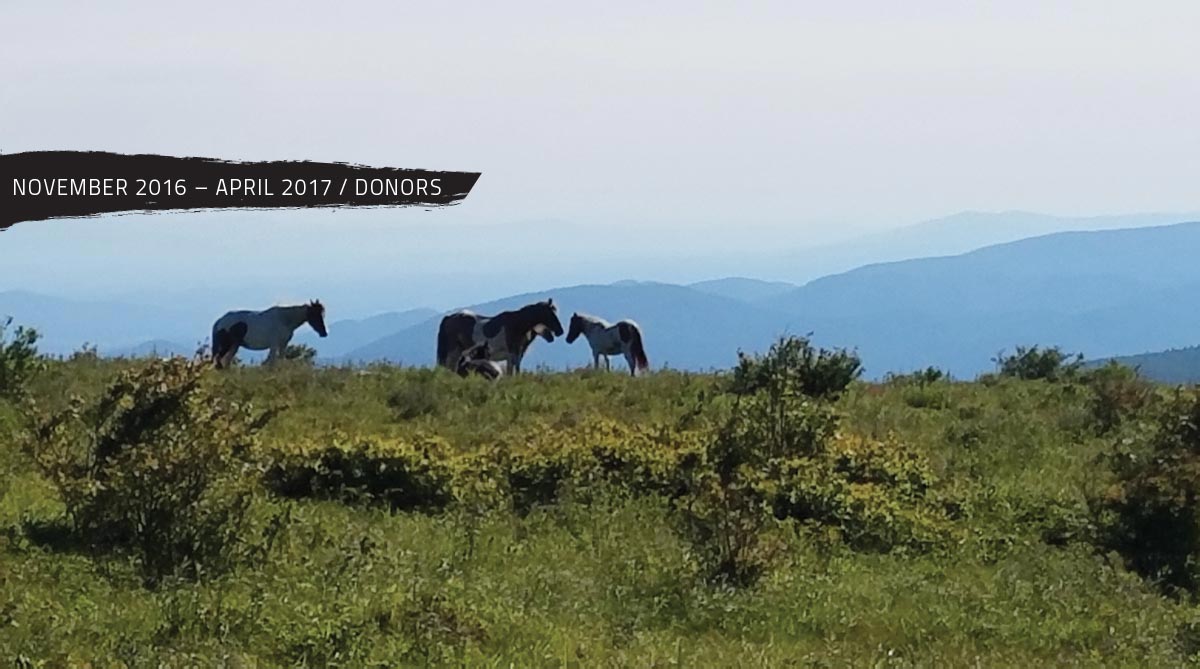
Grayson Highlands ![]() Photo by Jonny Bruce
Photo by Jonny Bruce
![]() CHAMPION
CHAMPION
$500,000 or more
The Estate of Robert J. Shlifer
The L.S. Bernstein Revocable
Living Trust
![]() LEADER
LEADER
$100,000 – $499,000
Stephen Corman
![]() PARTNER
PARTNER
$50,000 – $99,999
Fred & Alice Stanback
Greg* & Jan Winchester
![]() ADVOCATE
ADVOCATE
$25,000 – $49,999
Robert P. Coon
William W. Farkas
Rubén* & Valerie Rosales
![]() PROTECTOR
PROTECTOR
$10,000 – $24,999
Daniel Collins
Steve & Kathi^ Cramer
Norman* & Adrienne Findley
Daniel & Laura Gold
Mary Higley* & Kyran Kennedy
Robert L. Hueston
Robert* & Catherine Hutchinson
Robert G. Maxfield
David H. Raymond
Jennifer Reilly
Robert Salerno
The Estate of Joan Sibley
Betsy* & Bob Thompson
Ron Tipton* & Rita Molyneaux
![]() STEWARD
STEWARD
$5,000 – $9,999
Robert W. Becker
Bennett & Anne Cowan
Beth Bryan Critton*
Raymond E. Dessy
Audrey H. Duane
Arthur* & Denise Foley
Edward J. Gehringer
Pamela & James Grange
Brian B. King
Sandi Marra* & Chris Brunton
L. Hardy Mason
Art Morrow
Robert “Rhea” Patrick
George Perkinson
Judith Seay
Nathaniel C. Stoddard*
Evan Van Hook
C. Stewart Verdery, Jr.*
![]() SUPPORTER
SUPPORTER
$1,000 – $4,999
Anonymous (2)
Robert Allen
June C. Amer
Nancy D. Anthony
Mark Aronson
Jesse H. Austin, III
Phyllis Austin
Wendy Bailey
Tockie Baker
Albert Balducchi
Ron & Jill Balistreri
John & Jean Ball
Rebecca Barney
James Bates
Haskell Beckham
Laura & Buzz Belleville
Frank & Lucia Bequaert
David Berning
Plus Many More

Cabin for sale: Hike 15 minutes to Burnett Field Mountain on the Georgia section of the A.T. from your own mountainside, totally furnished 3 BR, 2 BA cabin. Ideal location for a Hiker Hostel, a full time home, or summer home. Asking: $169,900. Call: (706) 747-3735 or visit the Virtual Tour: suchesgarealestate.com
MLS #269242
The last ATC Biennial Conference will be held in Waterville, Maine August 4-11. This week-long gathering, held every two years since 1975, will be discontinued as the ATC transitions to annual business meetings (in 2018) and the new event, ATC Vista, the long-weekend hiking/activity program (in 2020). Also, it is coincidental that the last biennial is being held in Maine, where the last mile of the A.T. was completed in August, 1937. Volunteers from the Maine Appalachian Trail Club and the Maine Chapter of the Appalachian Mountain Club have planned a wonderful conference that will showcase the central section of the A.T. in Maine as well as the mid-coast section of the state. Come join us to mark the last biennial and the 80th Anniversary of the A.T. this summer. Pre-register by July 15 so we can better prepare or if later, register on site. Find more information at: www.atc2017.org.
New Campsite Pass in White Mountains Offers Substantial Discounts. A new pilot program introduced by the Appalachian Mountain Club allows any A.T. thru-hiker or section-hiker who pays for one night at a fee campsite to get a 50 percent discount at all other A.T. fee campsites through the White Mountains of New Hampshire. More info can be found at: appalachiantrail.org/updates.
African American History Hike – October 1 at 11:00 a.m. in Harpers Ferry, West Virginia — is being offered in celebration of the 150th anniversary of the founding of Storer College. On this one-mile ranger-led hike, learn the fascinating stories of how Harpers Ferry became the site of an influential institution of higher learning open to all regardless of sex, race, or religion. Register for this free event by contacting: [email protected].
The Appalachian Trail Conservancy (ATC) is recruiting for several internship positions for the fall of 2017 including: Public Relations, Social Media, Development Database, Development Events, and Lands Steward. Interns work on a wide variety of projects and tasks including everything from membership and development to conservation. An internship at the ATC is an excellent way to gain a hands-on, work-learn experience in a specific area of interest or field of study. For more information and to apply visit: appalachiantrail.org/internships.
The Appalachian Long Distance Hiking Association’s 36th annual “GATHERING” will be held on October 6-8, 2017, Columbus Day Weekend, at a new venue — the Southwest Virginia Higher Education Center in Abingdon, Virginia. ALL are welcome. See you there! More information is available at: www.aldha.org.
Public Notices may be edited for clarity and length.
![]()
[email protected]
Public Notices
P.O. Box 807
Harpers Ferry, WV 25425-0807
As I See It

Richard and his daughter Allison pause for a selfie during their hike
two years ago that I decided to take my oldest daughter to hike the A.T. with me. It was to be a bonding moment for she was to be leaving for a new job out of the city where we lived and I realized it would be a long time before she would return.
As a long-time hiker, Damascus, Virginia has always been a favorite town stop for me — easy to access, with multiple parking areas close to the Trail. I decided to do a quick overnighter north of town, driving to Elk Garden at Va 600 to park and hike in about 4.5 miles. It would be a fairly easy hike to the Thomas Knob Shelter and then set up camp surrounded by picturesque mountains and panoramic views.
I wanted this to be a special time that she would remember. I also wanted her to realize why I enjoyed hiking the A.T., what makes the Trail so special, and its importance. I wanted her to enjoy being out and being with me but more importantly I wanted her to get it, to connect to the Trail.
The hike was complimented by warm sunny weather and blue skies. Along the way, she took pictures of the wild ponies, the special fauna growing along the Trail, and the beautiful landscape surrounding us.
Support the Trail You Love



